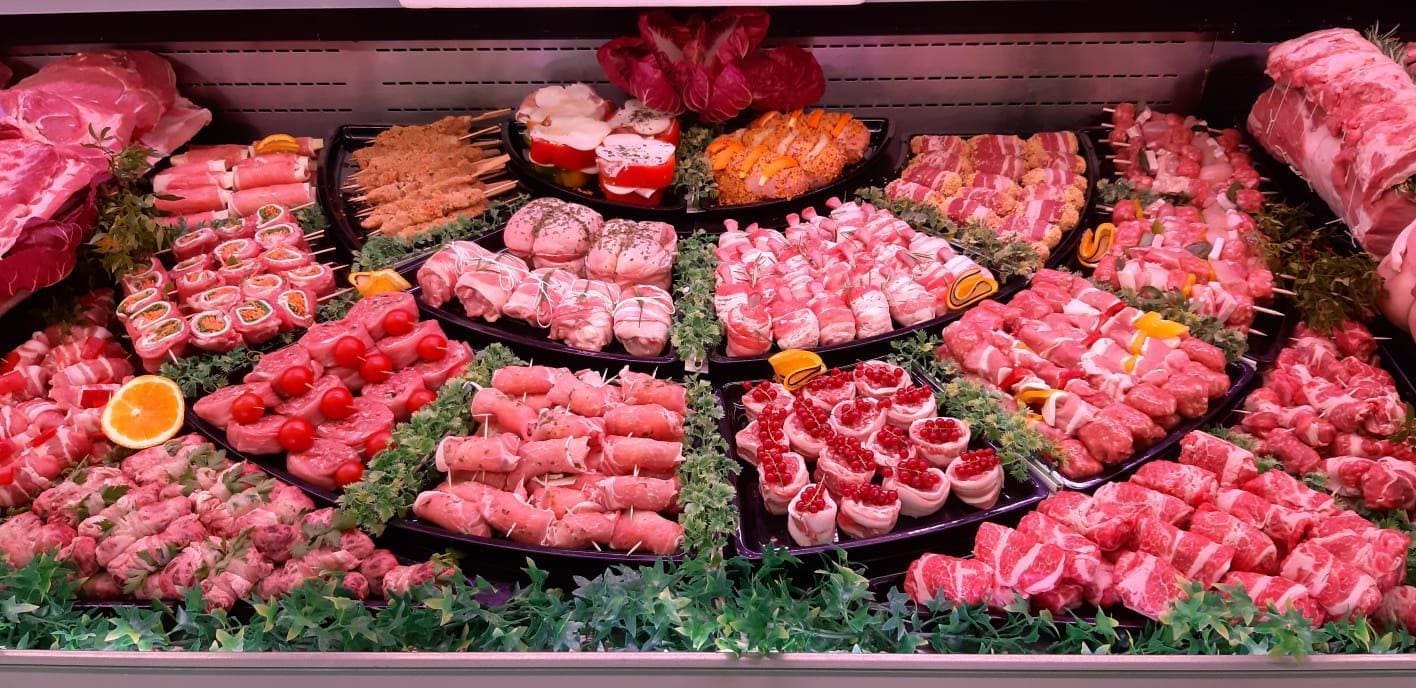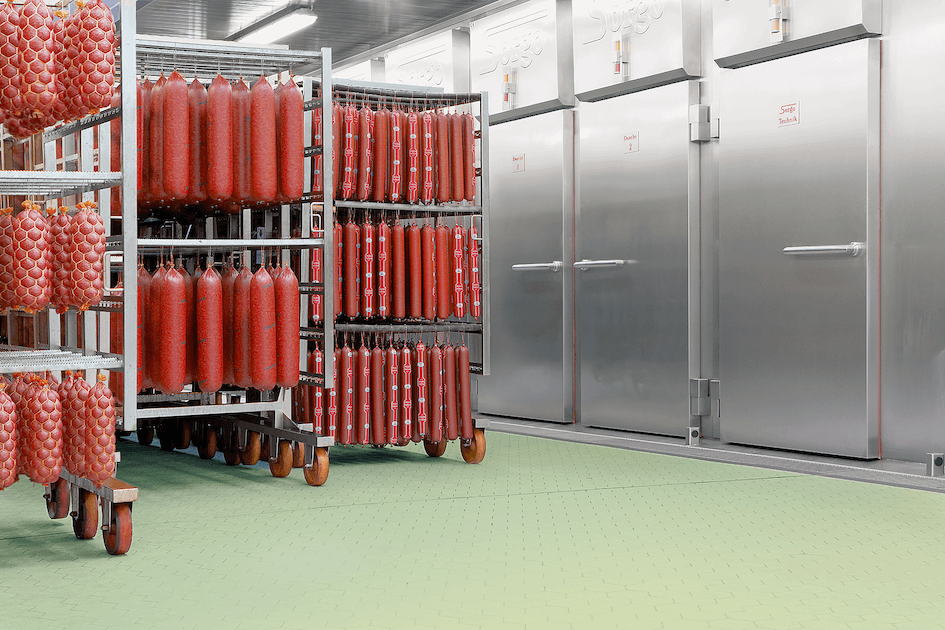One of man’s dreams is immortality, a concept bound indissolubly being healthy, which implies eating healthy.
In view of the fact that a large quantity of products, composing our daily diet, derives from cereals transformation (wheat, corn, barley, etc.), it follows that modern politics considers them as strategic products, as well as fundamental resources for a country’s economy, so their conservation is a social target, as well as agri-food. Storing a cereal for longer or shorter periods, in a rational and safe manner with the minimum cost of operation, is the task of a silo.
In order to choose the type of a silos to be adopted, many factors are involved, such as annual passing number, storage capacity, conveying capacity, conditioning and non-conditioning systems, possible treatments and other factors. In any case, the work cycles in a silos must be rapid, having the possibility to collect and to return the product at the same time, where the man must only check.
The silo capacity is a too subjective factor to allow practical suggestions, it depends on the purpose of the plant and the local market conditions as well as on economic-financial calculations. However, we could state, in the first analysis, that a silos plant with:
a. many cells, of modest capacity and with different grains, is used to make quality.
b. few cells with large individual capacities and few varieties of cereal, serves for convenience exploiting the market prices for supplying goods speculating on the cost (e.g. cereal purchase and storage during the harvesting period)

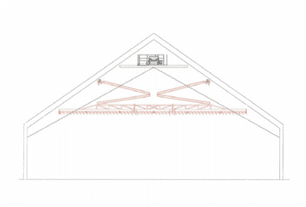
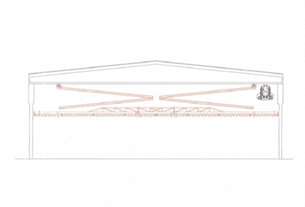
The silos are divided into two above mentioned large categories:
Vertical silos
Normally circular, polygonal, with hopper and/or flat bottom.
They can be made of metal, where they can reach a diameter up to 3035 m, with capacity up to 15.000 tons/each one or in concrete, generally with a diameter from 6 to 8 m with inter-bins and heights of 60-70 m (e.g. port silos).
However, we will deal with this type of silos in a special section.
Horizontal silos
Consisting of flat warehouses, today they represent the most economical system (ratio between cost and stored tons) for cereal storage and conservation (energy and labor necessary for the plant optimal functioning). Generally made of metal or reinforced concrete and/or pre-fabricated with variable dimensions: width 20-30m up to 50m and length over 100-150 m with storage height (side wall) ranging from 6 to 11 m, where the unit capacity is generally over 10.000 tons (finding in this situation an economic reason for the choice).
This type of silo is widespread in Brazil and Australia where, in the latter, it covers more than 10% of national storage with warehouses reaching up to 60.000 tons (133 m length, 54 m width, with 11 m average height storage).
The types of horizontal warehouses that we can meet are many, where the best known are the following:
As already above-mentioned, the horizontal silos (warehouses) can be made with reinforced concrete walls directly cast in place or with lateral pillars supporting the lateral curtain wall made of reinforced concrete slabs (prefabricated).
The flat warehouses can also be made with metal side walls where normally their walls are realized bending (Ωshaped) steel slabs directly bolted to pillars, always in steel, placed at a constant pitch (from 3 to 5 m ) on the warehouse perimeter.
The covering can be realized by means of prestressed concrete trusses or in metal where for important lights (over 30m) it is an obligatory choice. The theory used to calculate the pushing on the walls (a fundamental element for calculation and design) is the one best known as “land pushing”.
In the past the use of flat warehouses for the cereal storages aroused some perplexity due to the difficulties that could be encountered in the management of the stored grain, such as:
- difficulty in ensiling uniformly and constantly
- difficulty in intervening in case of non-conditioning
- difficulty of cereal return in compliance with health and hygiene rules
- difficulty of cereal conditioning
- difficulty in stocked mass temperature and humidity monitoring.
The new technologies and financial market trend (banks finance more willingly a flat warehouse than a vertical metal silos) represent an excellent alternative to storage in vertical silos. Take into account the company’s type of activity choosing the unit capacity or the type of silo to be adopted, horizontal or vertical.
DESCRIPTION OF A FLAT WAREHOUSE MECHANIZATION TYPE
A chain conveyor (1) is mounted in one side of the warehouse (normally the longest) for cereal loading and unloading destined to the warehouse storage, in fact:
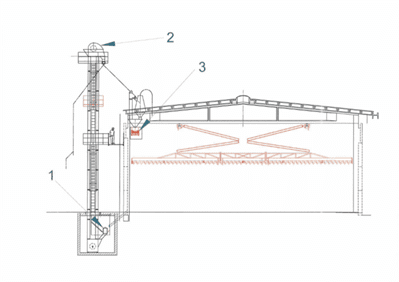
The conveyor is mounted on the bottom of a reception pit regularly covered by a self-supporting truckway grating along the entire length of the conveyor or only where it is strictly necessary (e.g. near the point of unloading of the vehicles and/or in other points, where it is deemed necessary, depending on the activity to be carried out).
The uncovered part is normally closed with reinforced concrete slabs or steel of suitable shape and thickness.
The vehicle will discharge the cereal inside this pit which, through the chain conveyor (1), will convey the cereal into the elevator (2). The elevator will raise the cereal and load the warehouse loading belt (3). The belt conveyor (3) will be equipped with a tripper (4) with a motorized advancement, able to discharge the cereal inside the warehouse on time.
The warehouse loading and unloading robot is positioned at the tripper discharging. This robot is substantially able to run along the whole length of the warehouse and it can rising and lowering for the whole height of the flat warehouse.
A screw conveyor system is installed on the lower part of the robot to move the cereal from side to side of the warehouse.
As it is easily understandable, once the cereal is discharged from the tripper and it touches the robot wormthreads, the same is pushed on the opposite side. When the cereal reaches the opposite side, a special rocker system will indicate that the cereal has reached the desired position, so it will drive the tripper to move in a predetermined measure; consequently the loading robot will move and repeat the same cycle up to the total filling of the warehouse.
Some shutters (5) incorporated into the wall, which obviously can be manual or motorized, are installed on the side where the reception pit is located, so the chain conveyor (3). The robot will be placed at the point where you want to unload the warehouse and the correspondent discharging shutter will open. It follows that before the cereal will fall down by gravity, after by means of robot and then it will be pushed towards the discharging shutter.
In this way the cereal will reach the discharging conveyor which, in turn, will convey the product to the elevator (2) placed generally at the head of the warehouse, under which a valve is able to carry out the following operations:
- return
- recirculation
- another operation (e.g. cleaning)
As shown in the operation description, the loading and unloading robot is the main performing element of mechanization.
DOWNLOAD HERE A FREE COPY OF FOOD PROCESSING 1-2022


